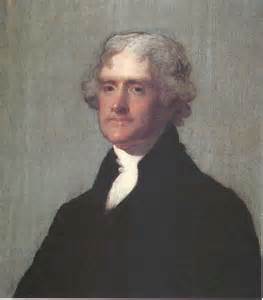The Democratic-Republican Party was one of America's first two political parties, most notable for its support of balanced government and for opposition to the Federalist Party. The Democratic-Republicans enjoyed a strong surge of support and a comfortable majority in Congress and occupation of the White House for more than two decades in the early years of the United States. Founded by Thomas Jefferson and James Madison about 1791, the Democratic-Republican Party found it first large target in the Bank of the United States. Jefferson and Madison disagreed with the "implied powers" argument of Federalist founder Alexander Hamilton, arguing that the formation of such a bank was outside the Government's powers as delineated in the Constitution and that states should take more of a role in financing the country's endeavors.
Jefferson was the nation's second Vice-president, elected to serve under John Adams in 1796. The Federalists pushed through the Alien and Sedition Acts, which proved to be very unpopular with the opposition party. In response, Jefferson wrote the Kentucky and Virginia Resolutions, which urged state legislatures to nullify laws that they thought were unconstitutional. The movement didn't get off the ground. The "Jeffersonians" also found a ready target in the Jay Treaty, which they thought was "cozying up" too much to their old enemy, Britain. These two issues, along with a growing sentiment in favor of more representative issues, increased the membership and influence of the Democratic-Republican Party. Jefferson (in the disputed Election of 1800) soon became his party's first President. Jefferson and his successors, Madison and James Monroe, served two consecutive terms each, and the Democratic-Republican Party enjoyed overwhelming success in Congress as well. As the country expanded westward, more and more frontier issues came to the fore of political debate, and the political discussions turned increasingly one-sided. In the aftermath of the War of 1812, the country was living through what many called the "Era of Good Feelings." The waning of the Federalist Party in the late 1810s meant that James Monroe ran for re-election unopposed. However, without the guaranteed stimulus of a political party in opposition, many in the Democratic-Republican Party began to lose their political fire. Jefferson (with the Louisiana Purchase), Madison (with the War of 1812), and Monroe (with the Monroe Doctrine) all took actions as President that ran counter to core principles of the party. Technically, the next President, John Quincy Adams, was a Democratic-Republican. The schism created by Adams' election, though, weakened the party considerably. All of these things, coupled with the explosion of westward settlement, led to the formation of a new party, the Democratic Party, which seized control of the political debate and, in 1828, the White House, with the election of Andrew Jackson. |
|
Social Studies for Kids
copyright 2002–2026
David White

 Strongest in the South, the Democratic-Republican Party favored the rights of state governments and the beliefs of farmers and rural landowners. In the struggle between France and Great Britain, the "Jeffersonians," as they were often called, clearly sided with France.
Strongest in the South, the Democratic-Republican Party favored the rights of state governments and the beliefs of farmers and rural landowners. In the struggle between France and Great Britain, the "Jeffersonians," as they were often called, clearly sided with France. 
